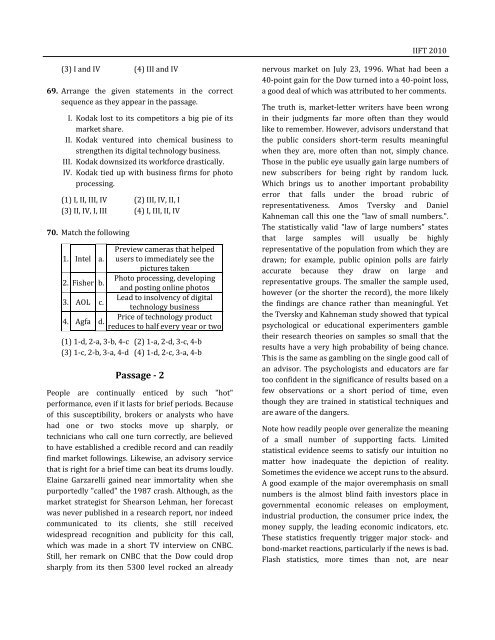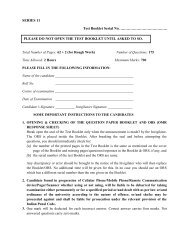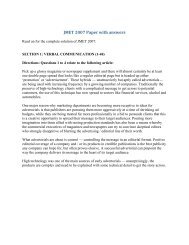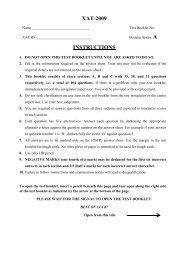PREVIOUS IIFT QUESTION PAPER
PREVIOUS IIFT QUESTION PAPER
PREVIOUS IIFT QUESTION PAPER
You also want an ePaper? Increase the reach of your titles
YUMPU automatically turns print PDFs into web optimized ePapers that Google loves.
(3) I and IV (4) III and IV<br />
69. Arrange the given statements in the correct<br />
sequence as they appear in the passage.<br />
I. Kodak lost to its competitors a big pie of its<br />
market share.<br />
II. Kodak ventured into chemical business to<br />
strengthen its digital technology business.<br />
III. Kodak downsized its workforce drastically.<br />
IV. Kodak tied up with business firms for photo<br />
processing.<br />
(1) I, II, III, IV (2) III, IV, II, I<br />
(3) II, IV, I, III (4) I, III, II, IV<br />
70. Match the following<br />
1. Intel a.<br />
2. Fisher b.<br />
3. AOL c.<br />
4. Agfa d.<br />
Preview cameras that helped<br />
users to immediately see the<br />
pictures taken<br />
Photo processing, developing<br />
and posting online photos<br />
Lead to insolvency of digital<br />
technology business<br />
Price of technology product<br />
reduces to half every year or two<br />
(1) 1-d, 2-a, 3-b, 4-c (2) 1-a, 2-d, 3-c, 4-b<br />
(3) 1-c, 2-b, 3-a, 4-d (4) 1-d, 2-c, 3-a, 4-b<br />
Passage - 2<br />
People are continually enticed by such "hot"<br />
performance, even if it lasts for brief periods. Because<br />
of this susceptibility, brokers or analysts who have<br />
had one or two stocks move up sharply, or<br />
technicians who call one turn correctly, are believed<br />
to have established a credible record and can readily<br />
find market followings. Likewise, an advisory service<br />
that is right for a brief time can beat its drums loudly.<br />
Elaine Garzarelli gained near immortality when she<br />
purportedly "called" the 1987 crash. Although, as the<br />
market strategist for Shearson Lehman, her forecast<br />
was never published in a research report, nor indeed<br />
communicated to its clients, she still received<br />
widespread recognition and publicity for this call,<br />
which was made in a short TV interview on CNBC.<br />
Still, her remark on CNBC that the Dow could drop<br />
sharply from its then 5300 level rocked an already<br />
<strong>IIFT</strong> 2010<br />
nervous market on July 23, 1996. What had been a<br />
40-point gain for the Dow turned into a 40-point loss,<br />
a good deal of which was attributed to her comments.<br />
The truth is, market-letter writers have been wrong<br />
in their judgments far more often than they would<br />
like to remember. However, advisors understand that<br />
the public considers short-term results meaningful<br />
when they are, more often than not, simply chance.<br />
Those in the public eye usually gain large numbers of<br />
new subscribers for being right by random luck.<br />
Which brings us to another important probability<br />
error that falls under the broad rubric of<br />
representativeness. Amos Tversky and Daniel<br />
Kahneman call this one the "law of small numbers.".<br />
The statistically valid "law of large numbers" states<br />
that large samples will usually be highly<br />
representative of the population from which they are<br />
drawn; for example, public opinion polls are fairly<br />
accurate because they draw on large and<br />
representative groups. The smaller the sample used,<br />
however (or the shorter the record), the more likely<br />
the findings are chance rather than meaningful. Yet<br />
the Tversky and Kahneman study showed that typical<br />
psychological or educational experimenters gamble<br />
their research theories on samples so small that the<br />
results have a very high probability of being chance.<br />
This is the same as gambling on the single good call of<br />
an advisor. The psychologists and educators are far<br />
too confident in the significance of results based on a<br />
few observations or a short period of time, even<br />
though they are trained in statistical techniques and<br />
are aware of the dangers.<br />
Note how readily people over generalize the meaning<br />
of a small number of supporting facts. Limited<br />
statistical evidence seems to satisfy our intuition no<br />
matter how inadequate the depiction of reality.<br />
Sometimes the evidence we accept runs to the absurd.<br />
A good example of the major overemphasis on small<br />
numbers is the almost blind faith investors place in<br />
governmental economic releases on employment,<br />
industrial production, the consumer price index, the<br />
money supply, the leading economic indicators, etc.<br />
These statistics frequently trigger major stock- and<br />
bond-market reactions, particularly if the news is bad.<br />
Flash statistics, more times than not, are near
















